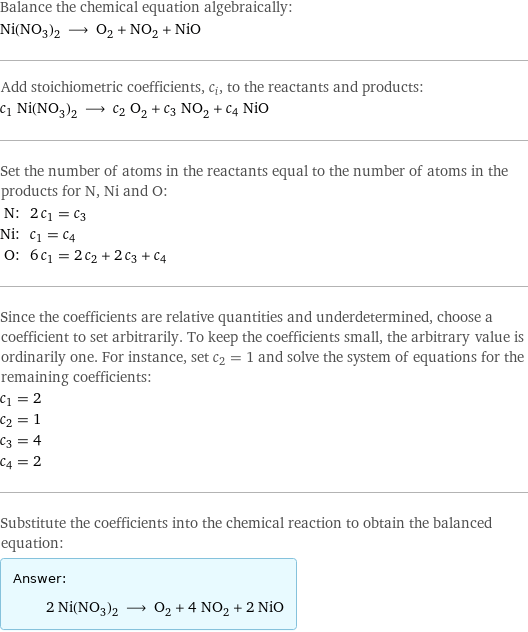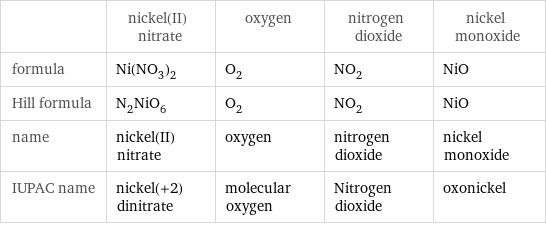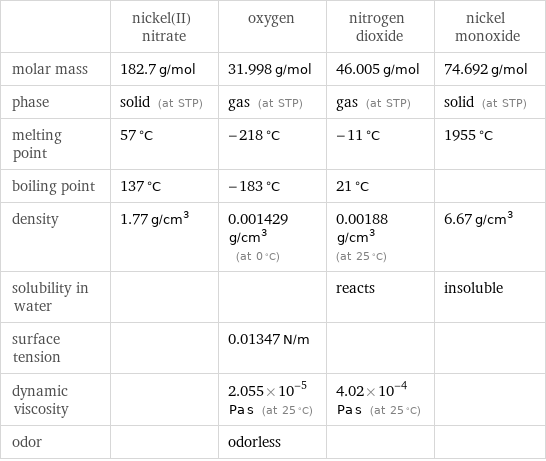Input interpretation

Ni(NO_3)_2 nickel(II) nitrate ⟶ O_2 oxygen + NO_2 nitrogen dioxide + NiO nickel monoxide
Balanced equation

Balance the chemical equation algebraically: Ni(NO_3)_2 ⟶ O_2 + NO_2 + NiO Add stoichiometric coefficients, c_i, to the reactants and products: c_1 Ni(NO_3)_2 ⟶ c_2 O_2 + c_3 NO_2 + c_4 NiO Set the number of atoms in the reactants equal to the number of atoms in the products for N, Ni and O: N: | 2 c_1 = c_3 Ni: | c_1 = c_4 O: | 6 c_1 = 2 c_2 + 2 c_3 + c_4 Since the coefficients are relative quantities and underdetermined, choose a coefficient to set arbitrarily. To keep the coefficients small, the arbitrary value is ordinarily one. For instance, set c_2 = 1 and solve the system of equations for the remaining coefficients: c_1 = 2 c_2 = 1 c_3 = 4 c_4 = 2 Substitute the coefficients into the chemical reaction to obtain the balanced equation: Answer: | | 2 Ni(NO_3)_2 ⟶ O_2 + 4 NO_2 + 2 NiO
Structures

⟶ + +
Names

nickel(II) nitrate ⟶ oxygen + nitrogen dioxide + nickel monoxide
Equilibrium constant
![Construct the equilibrium constant, K, expression for: Ni(NO_3)_2 ⟶ O_2 + NO_2 + NiO Plan: • Balance the chemical equation. • Determine the stoichiometric numbers. • Assemble the activity expression for each chemical species. • Use the activity expressions to build the equilibrium constant expression. Write the balanced chemical equation: 2 Ni(NO_3)_2 ⟶ O_2 + 4 NO_2 + 2 NiO Assign stoichiometric numbers, ν_i, using the stoichiometric coefficients, c_i, from the balanced chemical equation in the following manner: ν_i = -c_i for reactants and ν_i = c_i for products: chemical species | c_i | ν_i Ni(NO_3)_2 | 2 | -2 O_2 | 1 | 1 NO_2 | 4 | 4 NiO | 2 | 2 Assemble the activity expressions accounting for the state of matter and ν_i: chemical species | c_i | ν_i | activity expression Ni(NO_3)_2 | 2 | -2 | ([Ni(NO3)2])^(-2) O_2 | 1 | 1 | [O2] NO_2 | 4 | 4 | ([NO2])^4 NiO | 2 | 2 | ([NiO])^2 The equilibrium constant symbol in the concentration basis is: K_c Mulitply the activity expressions to arrive at the K_c expression: Answer: | | K_c = ([Ni(NO3)2])^(-2) [O2] ([NO2])^4 ([NiO])^2 = ([O2] ([NO2])^4 ([NiO])^2)/([Ni(NO3)2])^2](../image_source/492856caf53c2abc7f455d182bf7ede2.png)
Construct the equilibrium constant, K, expression for: Ni(NO_3)_2 ⟶ O_2 + NO_2 + NiO Plan: • Balance the chemical equation. • Determine the stoichiometric numbers. • Assemble the activity expression for each chemical species. • Use the activity expressions to build the equilibrium constant expression. Write the balanced chemical equation: 2 Ni(NO_3)_2 ⟶ O_2 + 4 NO_2 + 2 NiO Assign stoichiometric numbers, ν_i, using the stoichiometric coefficients, c_i, from the balanced chemical equation in the following manner: ν_i = -c_i for reactants and ν_i = c_i for products: chemical species | c_i | ν_i Ni(NO_3)_2 | 2 | -2 O_2 | 1 | 1 NO_2 | 4 | 4 NiO | 2 | 2 Assemble the activity expressions accounting for the state of matter and ν_i: chemical species | c_i | ν_i | activity expression Ni(NO_3)_2 | 2 | -2 | ([Ni(NO3)2])^(-2) O_2 | 1 | 1 | [O2] NO_2 | 4 | 4 | ([NO2])^4 NiO | 2 | 2 | ([NiO])^2 The equilibrium constant symbol in the concentration basis is: K_c Mulitply the activity expressions to arrive at the K_c expression: Answer: | | K_c = ([Ni(NO3)2])^(-2) [O2] ([NO2])^4 ([NiO])^2 = ([O2] ([NO2])^4 ([NiO])^2)/([Ni(NO3)2])^2
Rate of reaction
![Construct the rate of reaction expression for: Ni(NO_3)_2 ⟶ O_2 + NO_2 + NiO Plan: • Balance the chemical equation. • Determine the stoichiometric numbers. • Assemble the rate term for each chemical species. • Write the rate of reaction expression. Write the balanced chemical equation: 2 Ni(NO_3)_2 ⟶ O_2 + 4 NO_2 + 2 NiO Assign stoichiometric numbers, ν_i, using the stoichiometric coefficients, c_i, from the balanced chemical equation in the following manner: ν_i = -c_i for reactants and ν_i = c_i for products: chemical species | c_i | ν_i Ni(NO_3)_2 | 2 | -2 O_2 | 1 | 1 NO_2 | 4 | 4 NiO | 2 | 2 The rate term for each chemical species, B_i, is 1/ν_i(Δ[B_i])/(Δt) where [B_i] is the amount concentration and t is time: chemical species | c_i | ν_i | rate term Ni(NO_3)_2 | 2 | -2 | -1/2 (Δ[Ni(NO3)2])/(Δt) O_2 | 1 | 1 | (Δ[O2])/(Δt) NO_2 | 4 | 4 | 1/4 (Δ[NO2])/(Δt) NiO | 2 | 2 | 1/2 (Δ[NiO])/(Δt) (for infinitesimal rate of change, replace Δ with d) Set the rate terms equal to each other to arrive at the rate expression: Answer: | | rate = -1/2 (Δ[Ni(NO3)2])/(Δt) = (Δ[O2])/(Δt) = 1/4 (Δ[NO2])/(Δt) = 1/2 (Δ[NiO])/(Δt) (assuming constant volume and no accumulation of intermediates or side products)](../image_source/8b01f3fcbba1852daad235df6ed54ba0.png)
Construct the rate of reaction expression for: Ni(NO_3)_2 ⟶ O_2 + NO_2 + NiO Plan: • Balance the chemical equation. • Determine the stoichiometric numbers. • Assemble the rate term for each chemical species. • Write the rate of reaction expression. Write the balanced chemical equation: 2 Ni(NO_3)_2 ⟶ O_2 + 4 NO_2 + 2 NiO Assign stoichiometric numbers, ν_i, using the stoichiometric coefficients, c_i, from the balanced chemical equation in the following manner: ν_i = -c_i for reactants and ν_i = c_i for products: chemical species | c_i | ν_i Ni(NO_3)_2 | 2 | -2 O_2 | 1 | 1 NO_2 | 4 | 4 NiO | 2 | 2 The rate term for each chemical species, B_i, is 1/ν_i(Δ[B_i])/(Δt) where [B_i] is the amount concentration and t is time: chemical species | c_i | ν_i | rate term Ni(NO_3)_2 | 2 | -2 | -1/2 (Δ[Ni(NO3)2])/(Δt) O_2 | 1 | 1 | (Δ[O2])/(Δt) NO_2 | 4 | 4 | 1/4 (Δ[NO2])/(Δt) NiO | 2 | 2 | 1/2 (Δ[NiO])/(Δt) (for infinitesimal rate of change, replace Δ with d) Set the rate terms equal to each other to arrive at the rate expression: Answer: | | rate = -1/2 (Δ[Ni(NO3)2])/(Δt) = (Δ[O2])/(Δt) = 1/4 (Δ[NO2])/(Δt) = 1/2 (Δ[NiO])/(Δt) (assuming constant volume and no accumulation of intermediates or side products)
Chemical names and formulas

| nickel(II) nitrate | oxygen | nitrogen dioxide | nickel monoxide formula | Ni(NO_3)_2 | O_2 | NO_2 | NiO Hill formula | N_2NiO_6 | O_2 | NO_2 | NiO name | nickel(II) nitrate | oxygen | nitrogen dioxide | nickel monoxide IUPAC name | nickel(+2) dinitrate | molecular oxygen | Nitrogen dioxide | oxonickel
Substance properties

| nickel(II) nitrate | oxygen | nitrogen dioxide | nickel monoxide molar mass | 182.7 g/mol | 31.998 g/mol | 46.005 g/mol | 74.692 g/mol phase | solid (at STP) | gas (at STP) | gas (at STP) | solid (at STP) melting point | 57 °C | -218 °C | -11 °C | 1955 °C boiling point | 137 °C | -183 °C | 21 °C | density | 1.77 g/cm^3 | 0.001429 g/cm^3 (at 0 °C) | 0.00188 g/cm^3 (at 25 °C) | 6.67 g/cm^3 solubility in water | | | reacts | insoluble surface tension | | 0.01347 N/m | | dynamic viscosity | | 2.055×10^-5 Pa s (at 25 °C) | 4.02×10^-4 Pa s (at 25 °C) | odor | | odorless | |
Units
